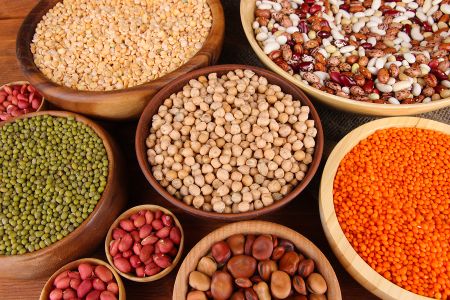What’s a pulse or legume?
Pulse comes from the Latin puls meaning thick soup or potage. Pulses are the edible seeds of plants in the legume family. The word ‘legume’ refers to plants whose fruit is enclosed in a pod. While there are several thousands of different species of legumes, more well-known ones include clover, alfalfa, fresh peas, soy, peanuts, and mesquite. Legumes make great crops, as they fix nitrogen into the soil as they grow. Farmers used to ‘rest’ fields and grow alfalfa and clover for a few years to increase the nitrogen content of soil before the introduction of artificial fertilizers.

The term ‘pulse’ refers only to the dried seed of legumes. The most common types include dried peas, beans, lentils, and chickpeas. Generally speaking, pulses/legumes are quite nutritious, high in protein and fiber, the minerals iron, zinc, phosphorus, and potassium, as well as B-vitamins. Pulses do not include fresh peas or beans, although they are related. Peanuts and soybeans mainly differ due to the fact that they are higher in fat, whereas pulses are virtually fat-free.
Nutritional benefits
Starchy carbohydrates
Pulses contain carbohydrate in the form of a type of complex starch which, given it’s structure, is slowly digested – helping to slow the rate at which the carbohydrate is absorbed, which helps keep the body’s blood sugar levels within a healthy range. Pulses also contain a unique type of carbohydrate called resistant starch, which acts like fiber. Resistant to being fully digested, they are a source of food for the beneficial bacteria in our gut, helping to promote their growth. Healthy gut bacteria work to maintain the well-being of our digestive tract and immune system, as well as hormonal balance related to weight management.
Some people find a particular type of starch in pulses/legumes, oligosaccharide, challenging to digest. Fortunately, there are preparation techniques that can help (see below).
Fiber
Fiber is a form of carbohydrate that our bodies are unable to digest. Pulses are very high in fiber, and both soluble (which helps to decrease blood cholesterol and control blood sugar levels) and insoluble (which helps to promote regularity and protect against intestinal disorders). Most individuals struggle to meet the recommended fiber intake set by the Institute of Medicine, which is 25 g per day for women and 38 g for men. Depending on the pulse or legume, a ½ cup or 85 g serving provides about 3-8 g of fiber.
Protein
Pulses wear many different nutritional hats. In addition to being a good source of slowly digestible starchy carbohydrates and fiber, they also contain a lot of protein, about 7-8 g per ½ cup or 85 g serving; in this sense, they are unique in the plant world because most plant foods have minimal to modest amounts. Pulses have about twice as much protein found in whole grain products, such as those made from wheat, oats, barley, or rice.
Other nutrients
Pulses/legumes also provide respectable amounts of potassium, phosphorus, magnesium, zinc, iron, and B vitamins. Pulses are also naturally gluten-free.
Cooking with pulses and legumes
Dried
Dried pulses and legumes are considered to be some of the most cost-efficient foods, delivering a lot of nutrition for very little cost. They can be cooked on the stove top, in a slow cooker or pressure cooker, or slow cooked in the oven. Regardless of the method used, acidic foods like tomatoes should be added only when the pulses/legumes are tender, because the acid and salt typically used in cooking slow down the cooking process.
Dried beans, peas and chickpeas should ideally be soaked before cooking to help speed up the cooking process. First, be sure to remove any shriveled or broken seeds, or any foreign matter (although rare, some may be present). Then rinse well using a colander. Using 3 cups of water for every 1 cup of dried pulses/legumes, soak in the refrigerator overnight or longer, for at least 12 hours – ideally for 48 hours to make digestion easier – changing the water several times. Alternatively, you can bring pulses/legumes and water to a boil in a saucepan, boil gently for 2 minutes, remove from heat, cover, and let stand for 1 hour.
Following soaking, cook the pulses/legumes in the same ratio of 3-to-1, for approximately 50 minutes over medium heat; final yield will be close to the amount of water used. To ease digestion challenges, cooking over low heat for 2-3 hours may lend an advantage.
Canned
Found in almost any store that sells foods, including your local corner convenience store, canned pulses/legumes are a pantry must-have. Because they are pre-cooked, they’re ready to use right from the can, whether you cooked them further like you would when making chili or tossed on a salad. Always drain the brine and rinse the pulses/legumes use; doing so will also reduce the sodium content by 40-60%.
Bottom Line:
Pulses are great tasting, inexpensive, easy to include and deliver a lot of nutritional bang for their buck. They are rich in good quality carbohydrates and protein, as well as nutrients such as B-vitamins, potassium, phosphorus, zinc, iron, and magnesium. They are naturally low in gluten, can be prepared to enhance digestibility, and so can be enjoyed by just about everyone. Pick some up today and start to include these nutritional powerhouses at your next meal!




Pulses are crazy simple to include in one’s diet!
First day today, I have made the sweet potato and carrot soup. I is lovely and a good stand by.
I am a lousy cook but made the daal recipe yesterday. Its very very easy and tasted wonderful…so much so, the whole family tucked in too. I have made a larger amount today and that has all gone too. Its a good job its easy to make.
Does one get an answer to questions put out there such as healthwalker below? What do I look for when looking for canned pulses/legumes?
I am following the meals applications but have never seen any of the beans I have selected in my food choices come up on my menus. I love beans and do not understand why I am not given bean choices. Am I missing something?
Hi I just made a big pot of chicken soup with soup mix ,barley split peas and yellow lentils and green lentils .Also added plenty of fresh vegetables,potato,pumpkin,sweet spud,corn, zucchini,cabbage,leek,onions,garlic,mushrooms and ginger.It was delicious and provided several portions to freeze or later.I used 1 litre of chicken stock and two chicken stock cubes to add flavour. Proved to be very economical and easy to make.
sounds delicious..it’s amazing how simple ingredients can make foods taste so great…
Love love beans! I’m gluten intolerant so beans and greens are my go to meal! Any greens, any beans with garlic and a little olive oil. Great meal.